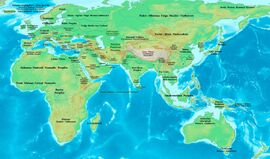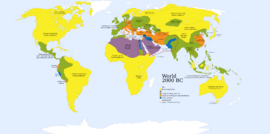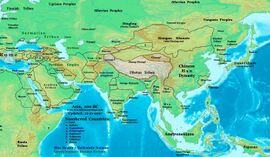Outline of ancient India
Topic: History
 From HandWiki - Reading time: 4 min
From HandWiki - Reading time: 4 min
Short description: none
The following outline is provided as an overview of and topical guide to ancient India:
Ancient India is the Indian subcontinent from prehistoric times to the start of Medieval India, which is typically dated (when the term is still used) to the end of the Gupta Empire around 500 CE.[1] Depending on context, the term Ancient India might cover the modern-day countries of Sri Lanka, Bangladesh, India , Nepal and Pakistan , though these territories had large cultural differences.
General history of Ancient India
An elaborate periodisation may be as follows:[2]
Pre-history (Neolithic Age) (c. 8000–3500 BCE)
- Indian Pre-history Age (c. 10,000–3300 BCE)
- Bhirrana culture (7570–6200 BCE)
- Mehrgarh culture (c. 7000 – c. 2500 BCE)
Bronze Age India (c. 3500–1750 BCE)
- Indus Valley Civilisation (c. 3300 – c. 1300 BCE)
- Ahar–Banas culture (c. 3000 – c. 1500 BCE)
- Ochre Coloured Pottery culture (c. 2600–1200 BCE)[3]
- Cemetery H culture (c. 1900–1300 BCE)[4]
- Indian Civilizations on peak Indus Valley Civilisation & "First Urbanization " (c. 3300–1750 BCE);
Iron Age (c. 1750–345 BCE)

The Indo-Aryan Vedic civilization and main polities in Eurasia around 1300 BC
- Iron Age India (c. 1750–345 BCE)
- Vedic civilization (c. 1500 – c. 600 BCE)
- Brihadratha dynasty (c. 1700–682 BCE)
- Gandhara Kingdom (c. 1500–545 BCE)
- Kuru Kingdom (c. 1200–345 BCE)
- Indian Iron Age kingdoms (c. 600 – c. 345 BCE)[8]
- Pandyan Kingdom (c. 600 BCE–650 CE)[9]
- Iron Age including Vedic period (c. 1750–600 BCE);
Pre-Classical Period (c. 600 BCE–250 CE)
- Pradyota dynasty (c. 682–544 BCE)
- Haryanka dynasty (c. 544–413 BCE)
- Shaishunaga dynasty (c. 413–345 BCE)
- Nanda Empire (c. 345 – c. 322 BCE)
- Maurya Empire (c. 322–185 BCE)
- Sangam period (c. 300 BCE – c. 300 CE)
- Pandyan Kingdom (c. 600 BCE–1650 CE)
- Chera Kingdom (c. 300 BCE–1102 CE)
- Chola Kingdom (c. 300 BCE–1279 CE)
- Kalinga Empire (until 250 BCE)
- Maha-Megha-Vahana Empire (c. 2600–300 CE)
- Satavahana Empire (230 BCE–220 CE)
- Kuninda Kingdom (c. 2600–350 CE)
- Shunga Empire (c. 185–73 BCE)
- Kanva dynasty (c. 73–26 BCE)
- Indo-Greek Kingdom (180 BCE–10 CE)
- Kanva Empire (75–26 BCE)
- Kushan Empire (30–375 CE)
- Indo-Scythian Kingdom ( c. 12 BCE–395 CE)
Classical Age (c. 250–500 CE)
There are varying definitions of this period.[note 1]
- Gupta Empire (c. 320–650 CE)
- Later Gupta dynasty (c. 490–750 CE)
- Vakataka Empire (c. 250 – c. 500 CE)
- Pallava Empire (c. 275–901 CE)
- Kadamba dynasty (c. 345–1347 CE)
- Western Ganga dynasty (c. 350–1024 CE)
- Vishnukundina Empire (c. 420–624 CE)
- Maitraka dynasty (c. 475 – c. 776 CE)
- Rai dynasty (c. 489–632 CE)
Culture in ancient India
Art in ancient India
- Music in ancient India
- Carnatic music
- Hindustani music
Language in ancient India
- Vedic Sanskrit
- Proto-Dravidian
- (Scripts)
- Tamil-Brahmi
- Pallava script
- Gupta script
- Kadamba script
Religion in ancient India
- History of Jainism
- History of Hinduism
- Historical Vedic religion
- Vedas
- Vedic mythology
- Vedic priesthood
- Historical Vedic religion
- History of Buddhism
Sport in ancient India
- Traditional games of India
Science and technology in ancient India
- Science and technology in ancient India
- Indian mathematics
- Indian astronomy
- List of Indian inventions and discoveries
- Indian martial arts
- Malla-yuddha
- Kalaripayattu
- Ancient Indian medicine
- Architecture
- Dravidian architecture
- Indian in Sanskrit epics
Organizations concerned with ancient India
Museums with ancient Indian exhibits
- India (clockwise)
- National Museum, New Delhi
- Patna Museum
- Indian Museum, Kolkata
- Government Museum, Bangalore
- Goa State Museum
- Kutch Museum, Bhuj, Gujarat
- United Kingdom
- British Museum, London
See also
Notes
- ↑ Different periods are designated as "classical Hinduism":
- Smart calls the period between 1000 BCE and 100 CE "pre-classical". It is the formative period for the Upanishads and Brahmanism[subnote 1] Jainism and Buddhism. For Smart, the "classical period" lasts from 100 to 1000 CE, and coincides with the flowering of "classical Hinduism" and the flowering and deterioration of Mahayana-buddhism in India.[11]
- For Michaels, the period between 500 BCE and 200 BCE is a time of "Ascetic reformism",[12] whereas the period between 200 BCE and 1100 CE is the time of "classical Hinduism", since there is "a turning point between the Vedic religion and Hindu religions".[13]
- Muesse discerns a longer period of change, namely between 800 BCE and 200 BCE, which he calls the "Classical Period". According to Muesse, some of the fundamental concepts of Hinduism, namely karma, reincarnation and "personal enlightenment and transformation", which did not exist in the Vedic religion, developed in this time.[14]
- Subnotes
References
- ↑ Stein 2010, p. 38.
- ↑ Michaels 2004.
- ↑ Civilsdaily, (August 15, 2017). "Case study | Pottery – Evolution and significance".
- ↑ M Rafiq Mughal Lahore Museum Bulletin, off Print, vol.III, No.2, Jul-Dec. 1990 [1]
- ↑ Franklin Southworth, Linguistic Archaeology of South Asia (Routledge, 2005), p. 177
- ↑ Strickland, K. M., R. A. E. Coningham, et al., (2016). "Ancient Lumminigame: A Preliminary Report on Recent Archaeological Investigations at Lumbini's Village Mound", in Ancient Nepal, Number 190, April 2016, p. 10.
- ↑ Neogi, Sayantani, Charles A. I. French, Julie A. Durcan, Rabindra N. Singh, and Cameron A. Petrie, (2019). "Geoarchaeological insights into the location of Indus settlements on the plains of northwest India", in Quaternary Research, Volume 94, March 2020, p. 140.
- ↑ Lal, Deepak (2005) (in en). The Hindu Equilibrium: India C.1500 B.C. - 2000 A.D.. Oxford University Press. p. xxxviii. ISBN 978-0-19-927579-3. https://books.google.com/books?id=dps-A5gOmA8C&pg=PR38.
- ↑ Geological Survey of India (1883). Memoirs of the Geological Survey of India. pp. 80.
- ↑ Smart 2003, p. 52, 83-86.
- ↑ Smart 2003, p. 52.
- ↑ Michaels 2004, p. 36.
- ↑ Michaels 2004, p. 38.
- ↑ Muesse 2003, p. 14.
Sources
- Flood, Gavin D. (1996), An Introduction to Hinduism, Cambridge University Press
- Khanna, Meenakshi (2007), Cultural History Of Medieval India, Berghahn Books
- Kulke, Hermann; Rothermund, Dietmar (2004), A History of India, Routledge
- Michaels, Axel (2004), Hinduism. Past and present, Princeton, New Jersey: Princeton University Press
- Misra, Amalendu (2004), Identity and Religion: Foundations of Anti-Islamism in India, SAGE
- Muesse, Mark William (2003), Great World Religions: Hinduism, http://www.docshut.com/rquv/lectures-on-great-world-religions-hinduism.html
- Muesse, Mark W. (2011), The Hindu Traditions: A Concise Introduction, Fortress Press
- Smart, Ninian (2003), Godsdiensten van de wereld (The World's religions), Kampen: Uitgeverij Kok
- Stein, Burton (2010), A History of India, John Wiley & Sons, ISBN 9781444323511, https://books.google.com/books?id=QY4zdTDwMAQC&q=history+of+india
- Thapar, Romila (1978), Ancient Indian Social History: Some Interpretations, Orient Blackswan, http://www.philoshistorydepartment.weebly.com/uploads/1/2/8/7/12870319/ancient_indian_social_history_some_interpretation_by_romila_thapar.pdf
External links
- Ancient India - The British Museum
- Ancient India - World History Encyclopedia
- TimeMaps Civilization: Ancient India
 |
Licensed under CC BY-SA 3.0 | Source: https://handwiki.org/wiki/History:Outline_of_ancient_India13 views | Status: cached on December 20 2023 20:33:03↧ Download this article as ZWI file
 KSF
KSF




